Autonomous Braking System For a Rollator Walker
Introduction
About 30% of elderly people ages 65 and older will fall annually. Falling at this age can cause fractures and brain injuries. Aside from physically harming an elderly person, a fall can create a fear of falling. Fear of falling can cause the person to become socially isolated, and a subsequent decline in health. In 2015, the medical cost in the United States of fall injuries was 31 billion dollars. To help prevent falls, engineers have designed many assistive devices for the elderly who have trouble walking. The walker is a commonly used assistive device. Walkers improve the stability of a person with a lower body weakness or poor balance.
Three types of walkers:
1. A standard walker – most stable walker, user has a slower gait because it must be lifted off the ground during use
2. A two-wheeled walker – less stable than the standard walker, user has a more natural gait, and does not need to be fully lifted off the ground
3. A four-wheeled walker (rollator) – least stable because of the wheels. It is ideal for someone with arthritis, a respiratory disease, or congestive heart failure. Its seat allows the user to rest when needed and is easier to navigate with because of the four-wheeled design. The problem is people with low grip strength or other impairments may have difficulty braking the device.
The purpose of this project was to create an autonomous braking system (ATBS) for a rollator walker that will apply a stronger and more reliable force than a regular manual braking system
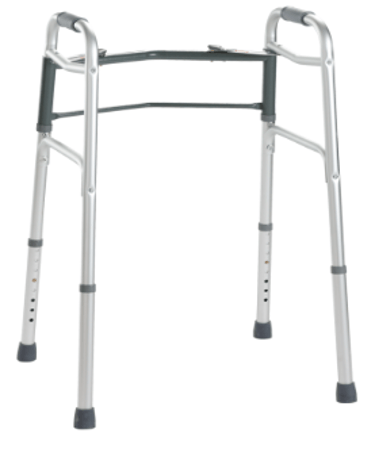
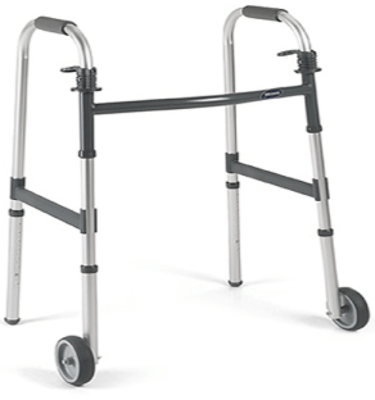
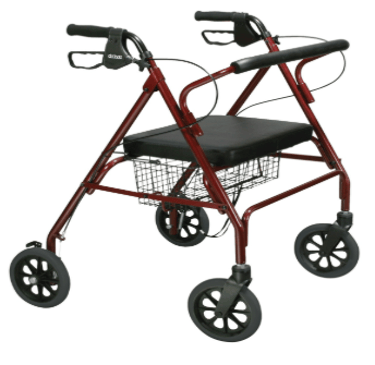



Phase 1
In phase 1 most of the research and development effort focused on creating an MVP for an autonomous braking system. This system needed to provide an increase in braking power, reliability, autonomy, and affordability.
After research into motors, sensors, and other autonmous systems the following design was created.
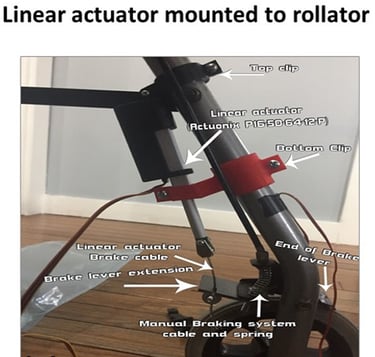

Design
A) Linear Actuators – are motors that drive a rod used to pull the cable that brakes the wheel of the rollator
B) Linear Actuator Controllers – are used for controlling the linear actuator's position, speed, and force
C) Inertial Measuring Unit – is a sensor used to detect the inclination angle of the rollator
D) Arduino Nano - is a microcontroller used for controlling the ATBS
E) 12v Battery – is used to power the ATBS
3D printed mounts for the linear actuators and the control systems were designed using Solidworks.
Experimental Design
The experiment aimed to evaluate the performance of an autonomous braking system compared to a manual braking system by measuring braking force under different conditions. Three tests were conducted:
IMU Angle Measurement Test
A digital inclinometer was zeroed on a level surface.
A wooden surface was set to predetermined angles (44°, 21°, 10°, and 5°).
An uncalibrated IMU was placed on the wood, and y- and z-axis angles were recorded three times per angle.
The process was repeated with the IMU calibrated.
Manual Braking Force Test
A strain gauge was bonded to each braking lever using MBond 610 adhesive.
The strain gauge was connected to a P-3500 digital strain indicator via an SB-10 Switch and Balance unit.
A Digital Hand Dynamometer was strapped to the right-hand brake lever.
The walker was secured with counterweights to prevent movement.
The brake lever was pulled upwards, and the applied force was recorded at different strain indicator values.
The test was repeated 30 times for both left and right brake levers.
Autonomous Braking Force Test
The strain gauge setup was repeated.
The Arduino-controlled actuator was programmed to extend to 34 mm (starting position).
Actuator positions were adjusted in increments of 1.4 mm (ranging from 33 mm to 25 mm), and braking force was recorded.
The test was repeated three times for averaging results.
This experimental design allowed for a direct comparison of manual and autonomous braking forces, assessing the consistency and effectiveness of the automated system.
Conclusion
In conclusion, the autonomous braking system using linear actuators provides a more consistent and powerful braking force compared to a manual brake system. The limitations of the manual system, such as force depletion due to lever mechanics and variations in user grip strength, reduce its effectiveness, especially for older adults who may have limited hand strength. In contrast, the autonomous system eliminates these human factors by applying force directly and efficiently, improving both reliability and safety. This study demonstrates that implementing an autonomous braking system in a rollator walker has the potential to enhance user safety and provide greater stability, particularly for individuals with reduced grip strength or dexterity.
Awards
Awarded second place in Engineering Category at the Maine State Science Fair
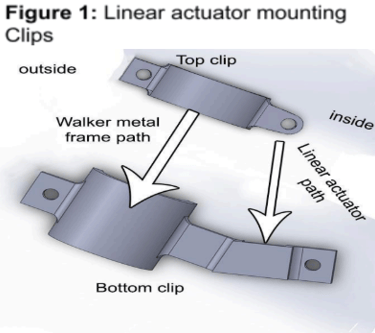

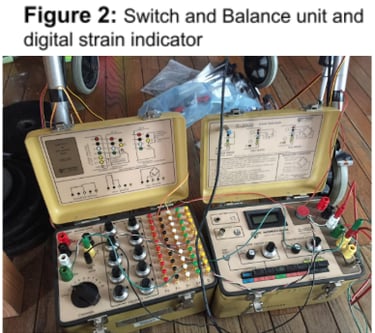

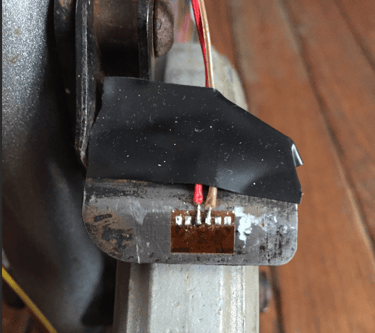

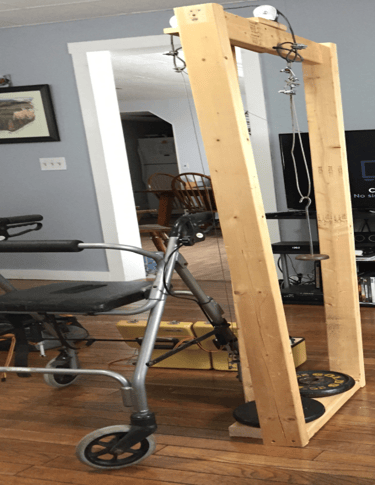

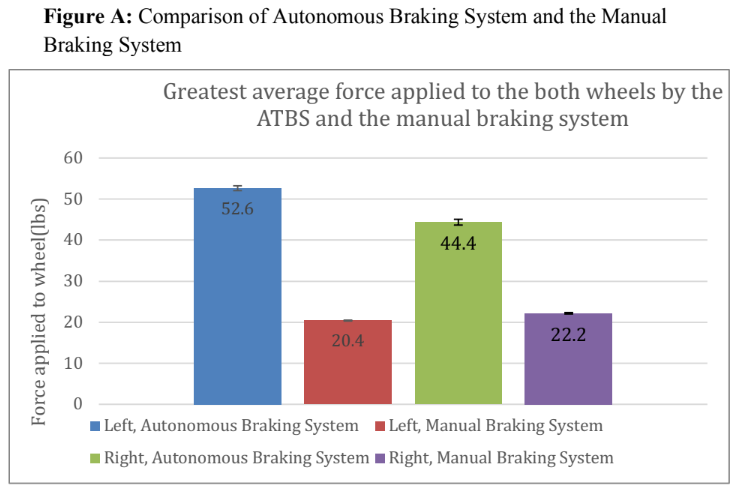

Mechanical Brake force test stand
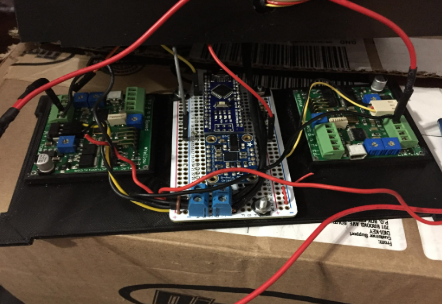

ATBS Control System
Phase 2
The second phase of this project aims to address the shortcomings of the first phase. The initial phase provided a conceptual design for a minimum viable product (MVP) of the Autonomous Braking System (ATBS). However, due to a lack of data, designing an efficient control algorithm proved challenging. Therefore, the primary focus of this phase is to refine the control algorithm for improved accuracy and responsiveness, optimize sensor placement and integration, and test the system in real-world conditions. Additional studies will evaluate long-term usability, durability, and user experience to ensure the system’s effectiveness across diverse environments. A human studies experiment was conducted to analyze the physical conditions influencing braking needs, using a rollator test device to record sensor data.
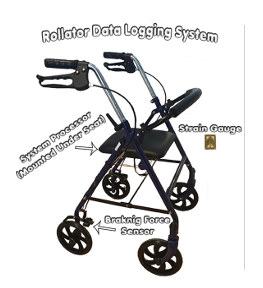

Brake Actuation and Hardware Design
The ATBS was designed to replicate the function of a manual brake lever by applying an upward force using a linear actuator. This actuator was mounted on the rollator frame using custom 3D-printed mounting clips, which were designed in SolidWorks™. The actuator was connected to the brake lever via a braking cable and powered by a 12V, 6Ah battery, which also supplied power to the sensors and control system. A custom brake lever was designed to replace the original lever to improve braking efficiency and accommodate force measurement strain gauges for real-time force monitoring.
Sensor Integration
To ensure effective and adaptive braking, multiple sensors were incorporated into the system:
Braking Force Sensor: A strain gauge-based system was used to measure braking force in real time. The dual shear type strain gauges were configured in a full Wheatstone bridge circuit, improving sensitivity and precision. The output from the strain gauges was amplified using an HTX711 load cell amplifier and transmitted to the microcontroller.
Angle and Acceleration Measurement: A Bosch BNO055 Inertial Measurement Unit (IMU) was integrated to measure acceleration, angular velocity, orientation, and inclination. The IMU was interfaced via I2C communication and provided data at 200 samples per second.
Speed Sensor: A reed switch and magnet system was used to track the rollator’s wheel rotations. The microcontroller measured the time interval between reed switch activations to calculate speed.
Computation and Control Algorithm
An Arduino Nano served as the microcontroller, processing data from all sensors and executing control commands for braking. The system was programmed in C using the Arduino IDE, with pre-existing libraries for the HTX711 amplifier and BNO055 IMU. The control algorithm analyzed sensor data—including speed and incline—to determine the necessary braking force for different conditions. The braking force was adjusted dynamically to slow, stop, or stabilize the rollator user as needed.
Test Device for Human Trials
A separate test device was designed for human trials to collect real-world sensor data under different walking conditions. This device included an Arduino Nano, IMU, speed sensor, and force sensor but did not have braking actuators. An SD card module recorded sensor data while users performed tasks such as walking, stopping, and navigating inclines. The collected data was used to refine the braking algorithm and optimize the ATBS for real-world conditions.
Conclusions
This study, though conducted with a small sample size from a single nursing home, revealed critical insights into the limitations of manual rollator braking systems. Among the 13 participants, two had previously experienced injuries while using a rollator, emphasizing the need for improved safety mechanisms.
The grip strength and braking force data demonstrated the necessity of an assisted braking system. The ATBS applied over twice the force of the manual braking system, ensuring greater and more consistent braking performance. In contrast, the manual system's effectiveness was limited by grip strength, fatigue, and ergonomic challenges related to handle design. Given that the average grip strength for individuals over 65 is below 65 lbs. for men and 46 lbs. for women, many older adults may struggle to apply sufficient force to stop the rollator effectively.
The IMU demonstrated adequate precision, confirming its suitability for ATBS integration. Brake force sensor calibration results were highly precise, and speed sensor calibration showed minimal variation in rotation counts per distance traveled. These findings support the system’s reliability.
A key observation from the human trials was that nearly half of the participants had grip strength marginally sufficient for manual braking. Combined with research on falls related to rollator use, these results underscore the need for an autonomous braking system to enhance user safety and reduce fall risks.
Future Improvements
To further develop the ATBS, the following steps are recommended:
Long-term data collection on regular rollator use to assess real-world performance.
Integration of trial data into the ATBS control algorithm for improved functionality.
Comparative human trials testing ATBS against the manual braking system.
Cost reduction by designing a specialized linear actuator and controller using off-the-shelf components.
Awards Received
Awarded the University of Maine Top Scholar full tuition Scholarship and The Office of Naval Research Naval Science Award.
Interview
https://www.wabi.tv/content/news/Bangor-High-School-student--507269831.html


Preliminary Experiments and Human Trials Summary
To ensure the effectiveness of the Autonomous Braking System (ATBS), several preliminary experiments were conducted to validate key components, including brake actuation, sensor calibration, and speed measurement. These experiments laid the groundwork for human trials, which were conducted to collect real-world data on rollator usage.
Human Trials Study
Location: Philips Strickland House, Bangor, Maine
Participants: Individuals 65+ years old capable of walking with a rollator.
Study Components:
Survey: Gathered physical characteristics and rollator usage experience.
Grip Strength Test: Participants used a grip strength dynamometer, squeezing five times per hand.
Walking Test:
Walk 20 feet, stop, then return while applying brakes (3 replicates).
Walk up and down a 6.5-degree incline (3 replicates).
Data was logged via SD card for later analysis.
This study provided critical real-world data on braking force, speed, and user interaction, helping to refine the ATBS algorithm and improve safety for rollator users.
Human Trials Study Findings
13 participants (2 men, 11 women), ages 69-97.
Injury history: 2 out of 12 regular rollator users reported injuries. One suffered a black eye, broken nose, and concussion.
Grip Strength Range:
Women: 9.2 lbs. – 40.9 lbs.
Men: 20.5 lbs. – 62.0 lbs.
Grip Strength Impact on Braking Efficiency:
Manual braking force was lower than grip strength, likely due to energy loss in the braking mechanism.
Estimated force required to stop wheel: ~7 lbs.
6 (left) and 7 (right) participants lacked sufficient grip strength to fully prevent wheel spinning.
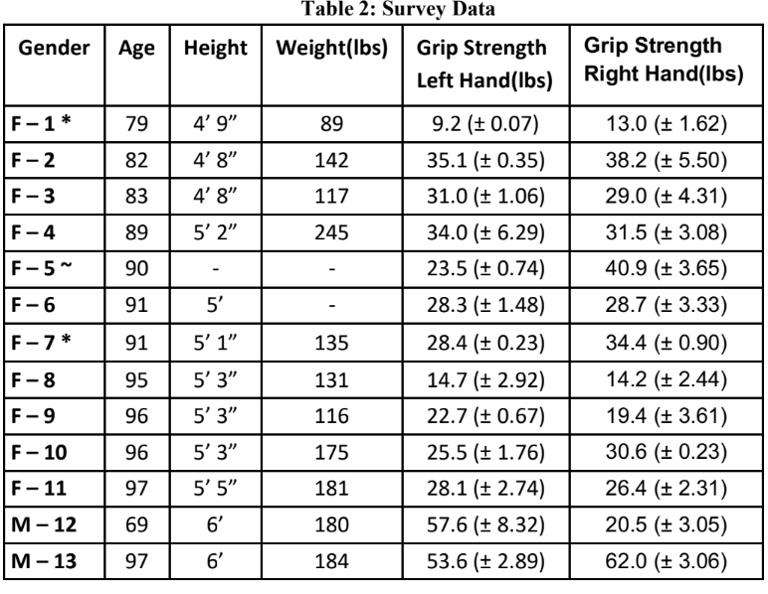

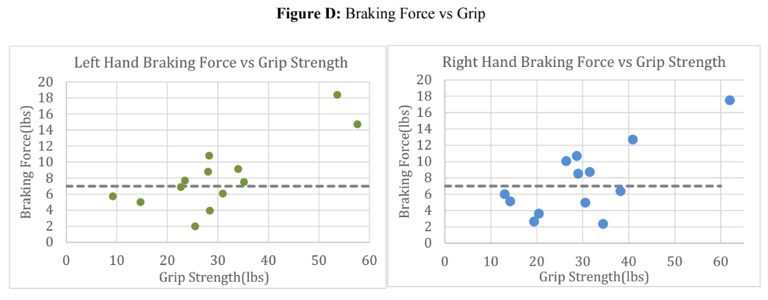

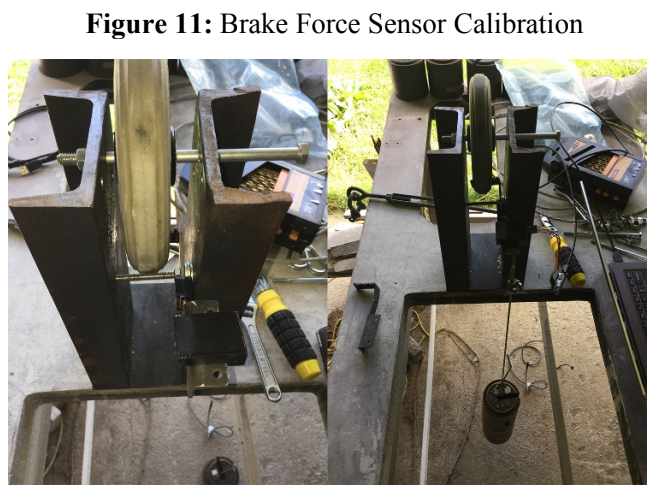

IMU Precision in Angle Measurement
IMU data was highly precise, with a maximum standard error of 0.22.
Accuracy confirmed across 0 to 10-degree angles, supporting its reliability for incline detection.
Brake Force Sensor Calibration
Calibration results were highly linear, with R² values:
0.9988 (Left Sensor)
0.9993 (Right Sensor)
Standard error was minimal, indicating consistent readings.
A difference in slopes was observed, possibly due to a Wheatstone bridge wiring issue in the right sensor.
Speed Sensor Calibration and Magnet Orientation
Rollator speed data was accurate, with a trendline slope of 0.992 counts per foot.
Key Finding: The magnet's orientation significantly affected sensor accuracy:
Improper orientation (North/South facing reed switch) → Double counting rotations.
Correct orientation (edge facing reed switch) → Single-count per rotation, ensuring accurate speed measurement.